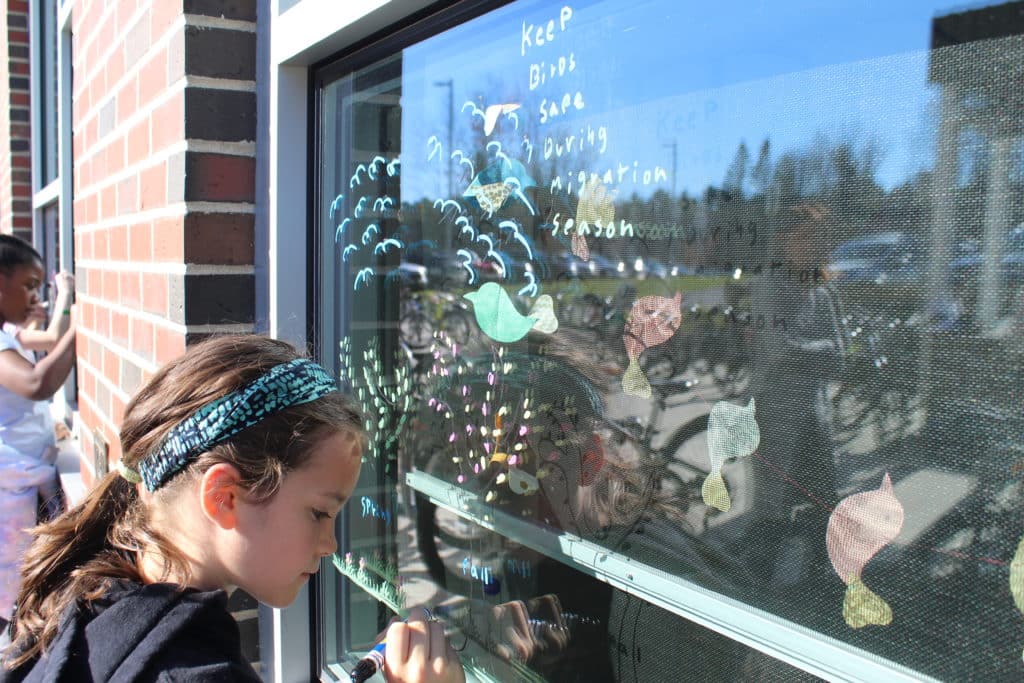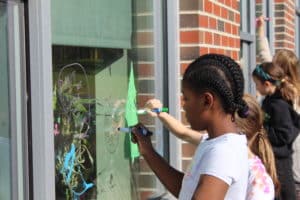
Something’s happening during recess these days at Yarmouth Elementary School. Instead of the shouts and sounds of a soccer game, there’s quiet. Groups of kids are standing, looking, listening. Yes, they’re birding!
According to Nicole Colfer, the school’s STEAM (science, technology, engineering, arts, and math) teacher, the kids have become more present in nature thanks to a unit of birds and birding that she and Bird Safe Maine volunteer Sonya Kahlenberg, wildlife conservationist and parent of a Yarmouth fourth-grader, are piloting at the school this fall. Bird Safe Maine is a partnership between Maine Audubon, the University of Southern Maine, and the Portland Society for Architecture to address the problem of bird-window collisions in Maine.
According to Colfer, this is the first year of having a STEAM lab at Yarmouth Elementary. So when Kahlenberg suggested the unit to Colfer, she jumped at the chance for a few reasons. “It ties in really nicely into the STEAM unit,” she says, “because we want to focus on real world problems and how to solve them.” Colfer had also found two birds killed from striking windows at the school so had seen the problem right there outside her classroom. Window strikes kill as many as one billion birds in the U.S. each year.
As a result, this fall 120 fourth-grade students at Yarmouth Elementary School have been learning all about birds and taking action to help them. As part of their STEAM classes, students had four lessons: an introduction to birds and species identification through taxidermy and technology; bird observation and identification in the field using field guides, apps, and binoculars plus nature journaling; all about migration; and all the threats that birds are facing, from climate change to habitat loss to collisions with windows.
On a recent bright sunny November day, a group of students decorated school windows with colorful drawings, designed to prevent collisions, as part of the last lesson. Fourth-grader Hazel O’Connor drew trees in spring and in fall, and wrote the message “Keep birds safe during migration season.” Maeve Dyer drew a cat with the message “Don’t let me outside.” Others drew Blue Jays, chickadees, trees, flowers, and as they drew, they talked about what they had learned from the unit.
“I was surprised to learn about how many birds die from windows and from cats,” said fourth-grader Otis Queally. Sylvie Mocciola said “I really learned a lot about migration. I didn’t know about all the threats that birds face, that they are not safe the whole way.” The students all mentioned how much they enjoyed the migration obstacle course activity, where they took on roles of birds and threats to migrating birds.
Colfer’s goal is to make the elementary school a bird-safe school and to have her students help spread the word. She, Kahlenberg, and interested students will help write a grant to ask for funding for a permanent solution to prevent bird collisions with windows at the school. The students will help present the grant before the Yarmouth Education Foundation. Kahlenberg and the Bird Safe team hope this pilot program will develop into a curriculum that can serve as a model for other schools.
When asked how many of them would be looking for birds after the unit is over, all of the Yarmouth students raised their hands. Favorite birds ranged from chickadees (“tough”) to Bald Eagles (“cool”). For now, it’s safe to say that the goals of the unit–introduce students to birds and get them excited about nature, and involve them in a project where they can make a real difference in conservation–have been met.


